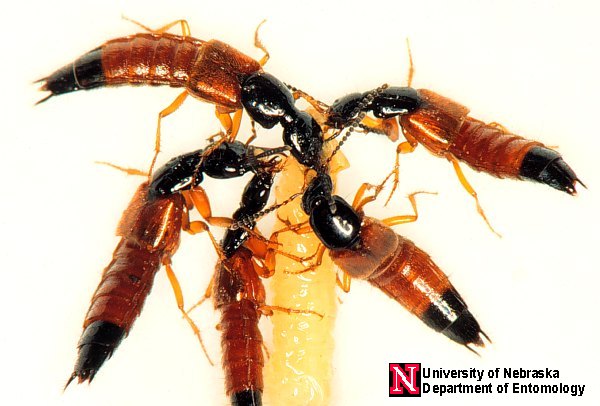Interactions
Aleochara bilineata is known both as a parasitoid and a
predator when it comes to North American crops and farmland
(Royer and Boivin 1999). The species of Delia radicum known
commonly as cabbage maggots are one of the natural herbivore
predators of brassicaceous crops (crops related to the cabbage
family). The D. radicum females lay their eggs at the base of
the plant so that when the larvae mature they tunnel through the
taproots and feed on the vascular tissues of the plant
(Broatch
et al. 2008). Once the vascular tissues of the plant are
damaged , the plant cannot transport its water and nutrients
causing damage or death. This loss of crops causes a deficit of
millions of dollars annually to farmers (Broatch et al.
2008).This is where A. bilineata factor in.
, the plant cannot transport its water and nutrients
causing damage or death. This loss of crops causes a deficit of
millions of dollars annually to farmers (Broatch et al.
2008).This is where A. bilineata factor in.
As a natural parasite and predator of the D. radicum
(cabbage maggot), A.
bilineata serves as a biological control agent for these crops.
By parasitism and predation on the maggot, A. bilineata
controls the population and therefore diminishes the loss of
crops for farmers (Royer and Boivin 1999). A. bilineata is a
predator to both the eggs and larvae form of the D. radicum. A
single adult beetle is capable of consuming an average of 23.8
eggs or 2.6 larvae per day. It was further concluded that under
optimum conditions a single pair of A. bilineata adults could
destroy about 1,210 eggs and 128 larvae in their lifetimes
(Broatch et al. 2008). Not only do the adult beetles destroy the
young maggots but they also parasitize on the pupae.
The pupae stage occurs when the insect is inactive in between
the larvae and adult stage (Webster Dictionary 2013). On average,
each female of A. bilineata can produce 9-to-15 eggs per day or
700 eggs in its lifetime. When the larvae of A. bilineata hatch
in under a week, they locate D. radicum pupae. Once the A.
bilineata larvae reach the pupae they proceed to chew a hole in
the wall of the puparium and then eventually consume the
developing maggot pupa inside (Broatch et al. 2008). A pupariu m
is defined as the last hardened larval skin that encloses the
pupa (Webster Dictionary 2013). Once the A. bilineata has completed
this process, it overwinters and emerges out of the puparium in
the spring as a full beetle adult (Broatch et al. 2008).
m
is defined as the last hardened larval skin that encloses the
pupa (Webster Dictionary 2013). Once the A. bilineata has completed
this process, it overwinters and emerges out of the puparium in
the spring as a full beetle adult (Broatch et al. 2008).
This process is a unique form of parasitism because the larvae
of the beetle are solely responsible for locating and inhabiting
the host pupa. Essentially, the mothers of the larvae have no
influence in the success or fitness of its offspring because
they do not select or evaluate the suitability of the host
(Balog et al. 2008). The parasitism process is able to occur
because the larvae are able to distinguish between parasitized
and non-parasitized hosts. This ability is very unique to the
Aleochara species and has never before been described in a
coleopteran (winged-insect) parasitoid of this nature
(Balog et
al. 2008).
This parasitoid relationship, along with the previously mention
predation relationship, is essential to farmers’ crops and was
found to be up to 94% effective in some Canadian territories
(Broatch et al. 2008). Therefore, it can be concluded that there
is a mutualistic relationship between the A. bilineata and the
cabbage crops. This is because the beetle provides protection
for the plant, and the plant is the home to the prey of the
beetle. This interspecies relationship is only one example of
the A. bilineata’s interactions with other organisms; however
this is the most studied relationship and has the most
prominence to our human culture and way of life.
Check out our reference page for more information on our facts and sources!
For more information on this interaction,
visit our Reproduction page.
Return home